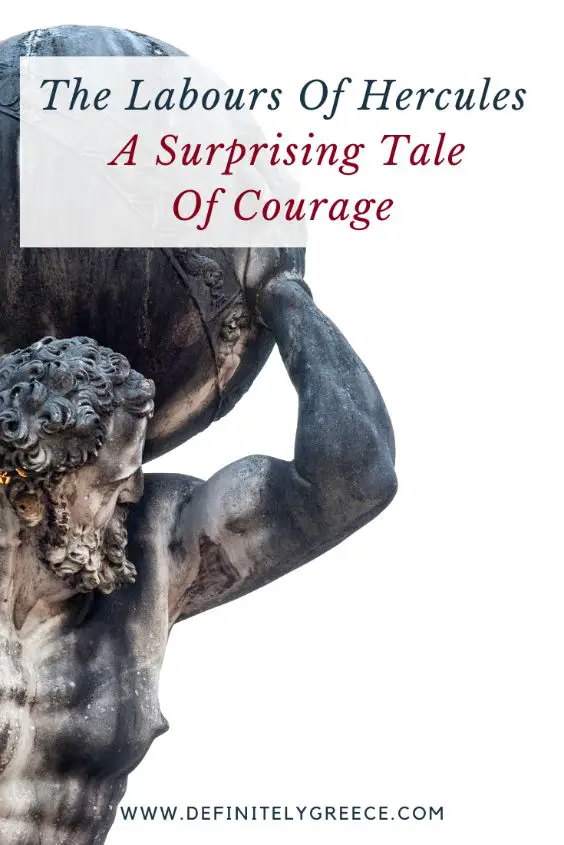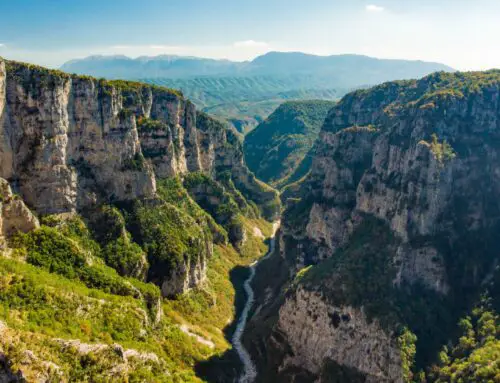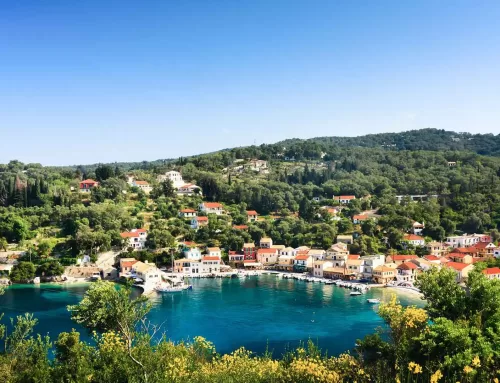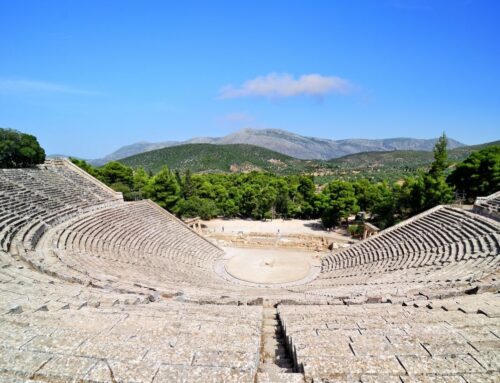
The Labours Of Hercules – A Surprising Tale Of Courage
The Labours Of Hercules – A Surprising Tale Of Courage

☞ Table of Contents:
You might not know this, but Hercules was the Roman name for this Greek hero. His Greek name was Heracles. He was the son of Alcmene and the Greek god Zeus. You are probably accustomed to the former, so just for the sake of convenience I will refer to him as Hercules from here on out! This is the story of the labours of Hercules.
What even less people know is that Hercules was originally called Alcides. However, Hera was one of the worst Greek gods for seeking revenge. Of all Zeus’s illegitimate children, Hera hated Hercules the most. In a vain attempt to placate her, his mother named him Heracles meaning ‘Hera’s glory’. But this made no difference to poor Hercules as Hera eventually tricked him into killing his wife and children, disguising them as dragons and demons.
Despite not being at fault, Hercules was made to atone for his sins. He was tasked with twelve labours, and only then he would be absolved of his crimes. The labours of Hercules, given to him by the King Eurystheus of Tiryns in Mycenae, consumed much of his life. But his atonement had an important role in eradicating the natural world of many of its monsters.
☞ Related: 5 Olympian ‘Gods’ And Their Greek Island
The Nemean Lion
The labours of Hercules began when Eurystheus ordered Hercules to kill the Nemean lion. The lions golden coat was impenetrable, so he had to rely on his strength alone. He strangled the lion until finally it gave its last breath. Upon killing the lion, he skinned it and wore its hide on his return to Eurystheus. The king realised he was going to have get more creative if he was going to defeat the mighty Hercules.
The Lernaean Hydra
The labours of Hercules were not going to be easy and on his second quest Hercules was sent to kill another fearsome beast. Lake Lerna was terrorised by an equally frightening mythological monster, the Hydra. This was a serpent that had nine heads, each capable of spraying a deadly poison. Hercules took his first swing, but to his horror in the place of the severed head, two more grew in its place! It was thanks to the help of his nephew Iolaus that he was able to defeat the Hydra. Hercules cut off each head and Iolaus seared the fresh wound preventing any new heads growing.
The Ceryneian Hind
The labour of Hercules that came next was an animal that did not pose any danger to mortals. But the Ceryneian hind was the ultimate challenge to hunters, no one had yet been able to catch her. More importantly the hind was sacred to the Greek goddess Artemis. Knowing this Eurystheus hoped Hercules would face the wrath of Artemis and perish. Artemis did indeed catch Hercules in the act of taking the hind, but it did not end as Eurystheus intended. Artemis was also an illegitimate son of Zeus, and she had experienced Hera’s spitefulness. Hercules explained that he meant the hind no harm and would release her which satisfied Artemis.

The Erymanthian Boar
The labours of Hercules led to the hero facing many mythological creatures. The fourth labour was again (surprise, surprise) a fierce beast ravaging yet another region of Greece. This time in northwestern Peloponnese, in Erymanthus mountain. His task was to bring it to Eurystheus. He did so, still alive. The King was so scared of this beast that he jumped into a giant stone jar, cowering in fear. ‘Remove it at once!’ he ordered. It is one of the labours of Hercules that has many depictions in history due to its wonderful comical value.
The Augean Stables
King Augeas of Elis had a herd of three thousand cattle. Eurystheus had a cunning plan involving this herd that became the fifth labour of Hercules. The cattle were immortal and of course over the duration of their lives produced an impossibly large amount of excrement. Eurystheus ordered Hercules to clean the Augean stables, but there was a catch. He had to complete the task in just one day! Hercules bet the King that if he managed to do it he would have to give him a tenth of his cattle. And do it he did. Quite easily in fact, by diverting two of the rivers in the region to wash right through the stables.
The Stymphalian Birds
Lake Stymphalia was the home of a horrible man-eating kind of bird. Perfect, Eurystheus thought, to become the labour of Hercules. These birds were formidable creatures that spread toxic excrement over the surrounding land, leaving it impossible to grow anything. The local people hated them. Luckily for Hercules, goddess Athena was on his side, and she provided him with a giant rattle created by Hephaestus. The rattle made an explosive sound that frightened the birds from the lake and forced them to the sky. Hercules was then able to shoot them down with the rest flying away for good.
The Cretan Bull
The Cretan Bull was a savage creature that became the seventh labour of Hercules. This creature was located on the Greek island of Crete.This time Eurystheus demanded the beast be brought to him alive and Hercules managed to take down the bull with his famous brute strength. First, he antagonised it until it ran straight at him, then took it by the horns and wrestled with it until the bull exhausted itself and succumbed. He was then able to ride it back to Eurystheus. This is where the phrase ‘take the bull by the horns’ comes from, a fact you might not have known about Greece.
☞ Related: The Top Ancient Greek History Facts For A Greek History Noob
The Horses Of Diomedes
The Thracian King Diomedes had four beautiful mares. The eighth labour of Hercules was to bring those four horses to Eurystheus. Sounds simple enough you might say? But these weren’t just any horses. The King fed them human flesh which made them crazed and dangerous. Hercules had come to Thrace with his lover at the time, Abderus, the son of Hermes. Naïve as he was the poor young man got too close to the horses and they devoured him. Heartbroken and to get revenge, Hercules threw Diomedes to his horses so he would suffer the same fate as Abderus. The taste of their master’s flesh dispelled the horses maddened temperament, which meant that Hercules was able to harness and ride them back to Mycenae.
The Girdle Of Hippolyta
This is the labour of Hercules that started out as a love story and ended in bloodshed. For this labour Hercules was to retrieve the girdle from the Amazon queen, Hippolyta. By this time Hercules had developed quite a name for himself, and despite fostering a particular distaste for men, the Amazons respected his power and welcomed him upon his arrival. The beautiful Hippolyta in particular had a fondness for Hercules that was strongly reciprocated and the two had an affair. To help him, she willingly offered the girdle to bring back. Their love affair, however, was short-lived. The goddess Hera took the form of an Amazon warrior and sowed seeds of doubt amongst the tribe. Hercules ended up killing Hippolyta and many Amazonians.
☞ Related: The Women Rulers Of Ancient Greece We Need To Remember
The Cattle Of Geryon
Geryon was a terrifying beast, giant in stature with three torsos and three heads. His herd of cattle was the prize that Hercules had to capture and retrieve. When Geryon found Hercules amongst his cattle, he was ready to kill him. But Hercules was too fast, shooting him with his poisoned arrows and presenting the cattle back to Eurystheus. This was, however, not the final labour as he had thought. Because he had received help with the second labour killing the Hydra and asked for payment by King Augeus when cleaning his stables, Eurystheus claimed they didn’t count and added two more tasks.
The Golden Apples of Hesperides
At this stage the labours of Hercules seemed to have no end in sight. The Hesperides were the three nymphs of the evening. In their garden grew a tree that sprouted golden apples each granting immortality to anyone that ate them. This tree was guarded by a dragon which Hercules slayed. Every time he tried to pick the apples however, they disappeared. He enlisted the help of the Titan Atlas, and in a trade, Hercules held the heavens for Atlas, while Atlas retrieved the apples for Hercules.
Cerberus
The final labour of Hercules was Eurystheus last chance to bring Hercules down. And for this he chose a labour that would surely be impossible. The last labour was for Hercules to retrieve the three headed guard dog of the underworld, Cerberus. But he managed to do it. The labours of Hercules had finally come to an end. Hercules was free.
*Disclaimer: This page might include affiliate links. If you decide to book something through one of them, I might get a little bonus, but it won't cost you anything extra.*





























